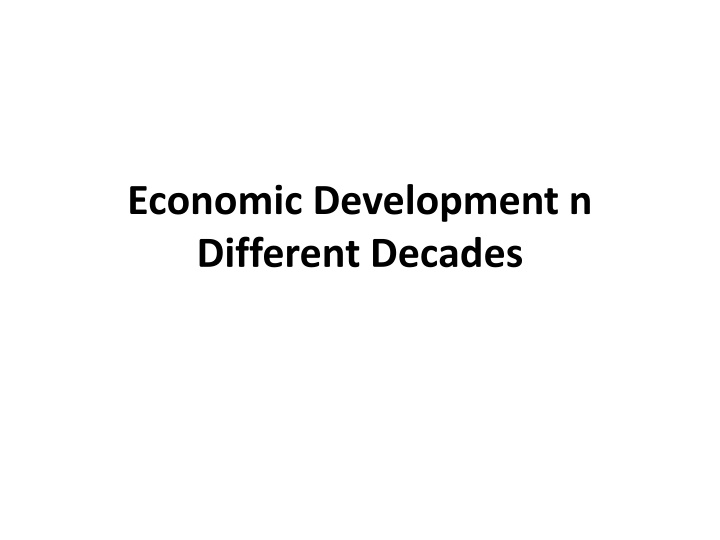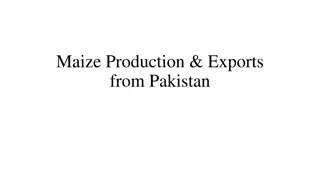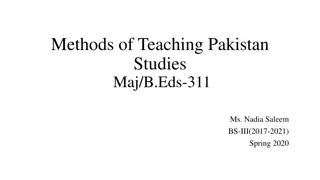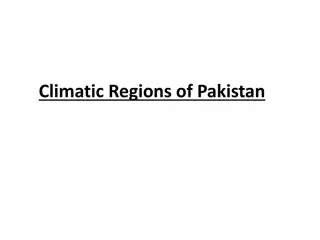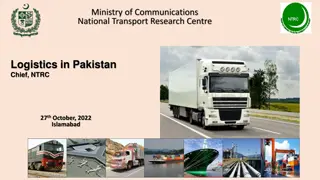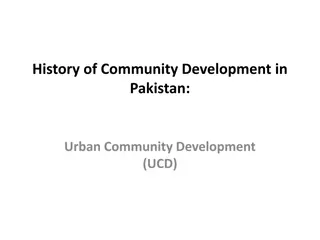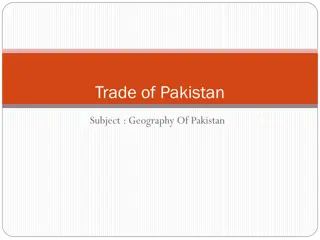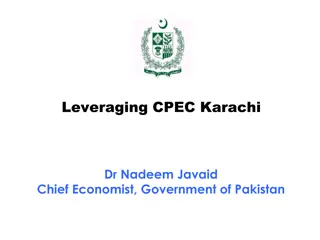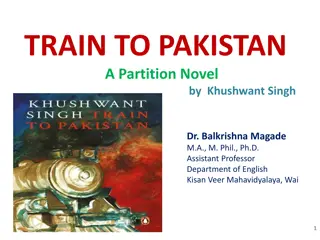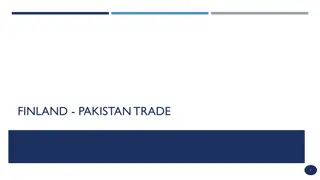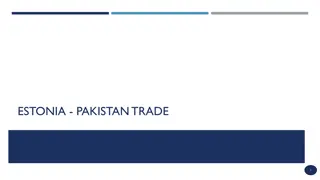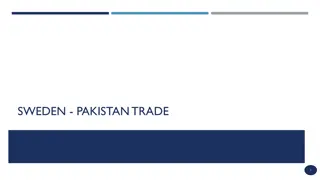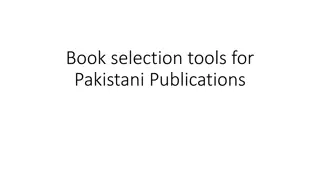Economic Development in Pakistan Over Different Decades
Pakistan's economic development over the past fifty years shows both impressive growth rates and disappointing human development indicators. Despite significant progress in economic growth and structural transformation, the country lags behind in crucial areas such as education, healthcare, infrastructure, and technology. The early years of Pakistan post-independence were marked by challenges in nation-building, migration of skilled individuals, and a focus on agricultural development with limited infrastructure.
Download Presentation

Please find below an Image/Link to download the presentation.
The content on the website is provided AS IS for your information and personal use only. It may not be sold, licensed, or shared on other websites without obtaining consent from the author.If you encounter any issues during the download, it is possible that the publisher has removed the file from their server.
You are allowed to download the files provided on this website for personal or commercial use, subject to the condition that they are used lawfully. All files are the property of their respective owners.
The content on the website is provided AS IS for your information and personal use only. It may not be sold, licensed, or shared on other websites without obtaining consent from the author.
E N D
Presentation Transcript
Economic Development n Different Decades
Pakistans economic record for the past fifty years is both impressive and disappointing. Impressive Disappointing Economic growth rates and per capita incomes have more than doubled despite a quadruple increase in population. Structural transformation has taken place from a predominantly agrarian economy to a more diversified production structure. The potential for growth and development has not fully realized relative to other countries at the same stage in the early 1960s. Human development indicators have lagged far behind compared to other Asian developing countries. Adult literacy rates, infant mortality and life expectancy are much below those justified by its per capita income level. Monetary and fiscal policies have been lax. Physical infrastructure, particularly power and roads are not up to the mark with the level of economic activity. Technological and scientific progress has been limited despite the acquisition of nuclear technology.
The Early Years At the end of WWII, decolonization and the movement toward independence gathered momentum. Colonies liberated from colonial fetters and new nations born. Pakistan, one of these nations, was born on 14 August 1947. The partitions of the Indian subcontinent created one country with two Wings, West Pakistan and East Pakistan, divided by more than a thousand miles of Indian territory. The complex task of nation-building required solid institutions, a functional administration and a large cadre of technocrats and civil servants to formulate the country s economic policy. Pakistan started its history with a net outflow of human capital, as skilled Hindu businessmen and technical workers migrated to India and without an entrepreneurial class that could fuel the industrial expansion. The prospects for Pakistan were not promising. Many of the early years were spent in the rehabilitation of refugees. However, the inward migration of 6.5 million Muslims brought an influx of workers as well mas a critical group of able civil servants who helped administer the country.
The Early Years One of the few positive features in Pakistan in 1947 was the substantial irrigation network that had been developed during the heyday of British rule and continuously expanded in the subsequent years. This system ensured that Pakistani agriculture would have a fertile background for the transfer of new technologies and institutions. Given the predominantly agrarian nature of the economy at Partition and the large dependence of Pakistani agriculture on cotton, rice, jute and wheat production, a viable irrigation system was a necessary input into the production process. However, a critical deficiency of other infrastructure, i.e., roads, power, railroads, was a serious constraint on development. By all token, Pakistan was an agrarian society with marginal trappings of infrastructure.
The Early Years The mixed initial endowment of resources and rudimentary institutions provided the critical background for Pakistan s attempts at nation-building. However, because of the writing of a constitution and the development of viable political institutions were the main priorities in the early years, macroeconomic management and economic planning were placed on the backburner.
The Early Years From 1947 to 1958, the Pakistani economy had an average annual GNP growth rate of 3.2 percent, a sluggish rate that showed the structural weaknesses of the economy. However, manufacturing grew at an impressive 9.6 percent and construction at a strong 6.8 percent. By contrast, agriculture lagged considerably, growing at only 2.8 percent. The reason for such overall low overall growth rate is that the economy was mostly centered around agriculture, with agriculture contributing to more than 50 percent of output. East Pakistan being a predominantly jute-growing area and West Pakistan heavily based on cotton. The manufacturing rate was high because the country started from such a minute base in 1947. Much of the industrial growth was concentrated in the protected consumer goods sector, with the large-scale manufacturing sector accounting for 5 percent of GDP.
The Early Years After the refusal to devalue the rupee in 1949 had led to a severing of trade links with India, the Korean War proved a huge blessing for Pakistan by causing an upsurge in demand for Pakistani exports, mostly raw cotton and raw jute and assisting in the creation of nascent entrepreneurial class. A post-war recession led to a re-examination of policy and a rigid system of import licensing is instituted to prevent Pakistan from having balance of payments difficulties and foreign exchange constraints. The idea was that the balance of payments position could only be maintained in equilibrium if imports were sharply curtailed through the licensing regime. Thus, what began as a series of exchange rate realignments was slowly evolving by the mid-1950s into a cumbersome web of administrative controls and intricate licensing systems that would form the backbone of Pakistan s import substitution industrialization (ISI) regime. The ISI regime, which was to bring notoriety to Pakistan s trade and industrial structure in later years, was based on the idea that the development of a strong local industrial capacity was absolutely essential for development, and that dependence on agricultural commodities spelled disaster for an economy.
The Early Years In order to develop local industries, the government provided Pakistan s manufacturing sector with generous fiscal incentives, heavy protection, preferential access to foreign exchange allocation for imports of capital goods and credit at low, controlled interest rates. Unfortunately, this policy regime set the foundation for rent-seeking by Pakistani businessmen. The flourishing of the black market in import licenses and the need for political connections to ensure access to cheap credit and fiscal incentives, paved the way for a private-public sector relationship. Rent-seeking behavior was legitimized throughout the economy, and a class of industrialists was created who made huge markups for themselves and their families. The state s capacity to tax these profits was virtually non-existent as the institutions had not been put into place. The simultaneous coexistence of large pockets of private wealth and low tax revenues had its unfortunate roots in the 1950s.
The Early Years An important characteristic of this period, especially in contrast to later periods was the very modest inflow of foreign capital, averaging about 1 percent of GDP per year. Two large transfers compounded the anomalies in Pakistan s industrial policy of the period. The transfer of resources from East to West Pakistan, and from agriculture to protected and inefficient industry. Industrialization was encouraged in West Pakistan, while East Pakistan remained a raw jute exporter with net transfer of resources estimated to have been equivalent to 2-3 percent of West Pakistan s GDP during 1950-60. The industrialization of West Pakistan was achieved at heavy cost to agriculture. Food shortages were experienced during the period and the fact that Pakistan became a net food importer in spite of such fertile agricultural land and well- developed irrigation system.
The Ayub Decade The period from 1958 to 1969 was dominated by the military rule of General Mohammad Ayub Khan, a leader whose regime was characterized by the paradoxical combination of the biggest growth rates in Pakistani history and large increase in income inequality, inter-regional differences and the concentration on economic power. Economic indicators are extremely impressive. Agriculture grew at a rate of 4.1 percent, manufacturing sector with growth rate of 9.1 percent and trade having growth rate of 7.3 percent. GNP growth rate was 6 percent during the decade. In sectoral terms agriculture shrank to 41.5% of the GDP while manufacturing increased to 15%. Income inequalities increased substantially in the 1960s. The GINI Coefficient worsened and the number of people below the poverty line increased. Real wages increased only by 2% in the ten year period.
The Ayub Decade Centerpiece of Ayub s economic legacy was the commitment to rapid industrialization. The Ayub administration paid no attention to the issues of equity and social justice One of Ayub s main action was to strengthen the administrative capacity. Political instability was rampant in the 1950s. Governance improved with an expansion in the capacity for political analysis, design and implementation. A Planning Commission was created whose responsibility was to formulate a series of five year plans. Key priority of the Ayub administration was to achieve rapid rates of economic growth and develop the industrial sector. In contrast to the Indian model of public sector-led industrialization, Ayub chose to center his strategy on the private sector. In order to achieve this, the Second Five- Year Plan (1960-65) envisioned the removal of administrative controls and the maintenance of monetary discipline and price stability to provide a macroeconomic environment conducive to private investment.
The Ayub Decade Pakistan Industrial Development Corporation (PIDC) was formed to spearhead the industrialization drive by providing capital. Industrial profits became more widespread an entrepreneurial class emerged which helped accelerate the rate of growth in large scale manufacturing sector to more than 15%. To facilitate industrialization the Export Bonus System (EBS) was introduced, which gave a premium to exporters. The growth rate of exports increased to 7% a year. Large diversification of the composition of Pakistan's exports with cotton textiles and jute textiles replacing primary commodities. 90% of the export growth in the 1960s was due to the increase in manufactured exports which grew at 20% annually. There was a significant dismantling import licensing and hence greater ease in importing raw materials and machinery.
The Ayub Decade However, in spite of the success in industrial diversification and export performance, the Ayub policies had several shortcomings. High rates of protection continued to make Pakistan industry inefficient. The ISI regime resulted in the worsening in the balance of payments with the increase in machinery and raw material imports outweighing export performance. In 1960s there was increased reliance on foreign aid. The strategic plans of the Cold War and the project-related assistance of the international development institutions combined to provide vital resources to Pakistan. External economic assistance as a percentage of GDP was 2.8% in 1960, reached 6.6% by 1965. One of the negative features of Ayub s policy was the deliberate repression of wages. The growing concentration of wealth and conspicuous consumption led many to question Ayub s industrial strategy.
The Ayub Decade One salient point was the reversal of the agriculture neglect. A series of reforms strengthened the Pakistani agriculture sector. Rural infrastructure investment was increased to improve the overall availability of irrigation water and cultivated land. Two factors that contributed to the revival of the agriculture sector were the Green revolution , characterized by the high yielding varieties of rice and wheat and mechanization and diffusion of technology among agriculture producers. In the latter half of the 1960s production of wheat and rice increased by more than twofold. Cotton and sugarcane production also increased in the 60s. The provision of subsidies for irrigation , fertilizers and pesticides allowed farmers to obtain agricultural inputs and reduced there cost of production. Parallel to this was the rapid diffusion of agriculture technology, private tube wells, tractors. Tube wells increased 16 fold and fertilizers 13 fold at the end of the decade. Tractorization and private tube wells had adverse distributional implications.
The Ayub Decade One of the major implications taken by Ayub was his quest to reduce the high population growth in Pakistan. Programme was launched in the 1960s. A highly-publicized program was launched in the mid-1960s. Based on a clinical approach to family planning that would involve rural midwives in the dissemination of contraceptive information, the program received substantial international interest. However, the 1971 war led to the abandonment of this scheme. In sum, the legacy of Ayub was mixed. While the consolidation of economic management and the high growth rate were important achievements, the growing income inequality and wage stagnation, the neglect of human capital, and the growing dependence on foreign capital inflows all promised a less than rosy inheritance for future regimes.
Flirtation with Socialism In 1971, Pakistan lay traumatized by the secession of East Pakistan and the defeat in the war with India. The end of the war was marked the accession to power of Zulfiqar Ali Bhutto, a charismatic leader who envisaged a broad restructuring of the country s industrial and agricultural sector. The period from 1971 to 1977 was to witness the most ambitious socialist oriented reforms in Pakistan s history and the strongest attempt to assert outside political authority over the country s bureaucracy and army. Economy s performance was worst during these years. although GNP growth rate was a respectable 5 percent, agriculture and manufacture had very sluggish growth rates, with 2.3 percent and 3.2 percent.
Flirtation with Socialism This was also the period when Pakistan s domestic macroeconomic management was constrained by a series of exogenous shocks, causing significant macroeconomic instability. Firstly, the secession of East Pakistan after a brutal civil war led to a disruption of trade relations between the two countries and a loss for West Pakistan of half of its export market and one-fifth of its import source. Secondly, the 1970s marked the beginning of a series of oil shocks induced by the newly-powerful OPEC cartel. The fourfold increase in petroleum prices led to great increases in Pakistan s import bill and a slowdown in exports due to the contraction in the world economy. Thirdly, the 1970s was a period of substantial fluctuation in the international prices of Pakistan s commodity export - rice, cotton and sugarcane-making export performance highly uncertain. Fourthly, a combination of bad weather, flooding and pest attacks adversely affected the production of cotton, which considerably weakened the economy.
Flirtation with Socialism In order to stimulate the economy, one of the key decisions of the Bhutto administration upon accession to power was the devaluation of the rupee in 1972. This decision led to a phenomenal surge in exports as Pakistan found new markets to replace the loss of the East Pakistan trade. The most dramatic decision of the Bhutto regime was the nationalization of large private manufacturing and financial institutions. In 1972, all private banks and insurance companies and a large number of manufacturing units were taken over by the state with the objective of reducing the concentration of wealth and diluting the power of the private industrialists. Bhutto s idea was to establish a powerful public sector that could govern the commanding heights of the economy and spearhead the industrialization drive. It is important to note the limited outcome of the nationalization campaign. The government takeover of capital and intermediate goods brought only 20 percent of the total value-added of the large-scale manufacturing sector under government control, while leaving intact much of the privately-owned industry in the textile and consumer goods sector. Bhutto reforms had far-reaching effects on the industrial structure of the economy, as well as on the nature of the relationship between the public sector and the private sector.
Flirtation with Socialism The outcome of nationalization was not favorable. The large-scale manufacturing sector performed very sluggishly during this period, having a growth rate of only 3 percent. Inefficiencies proliferated as inexperienced managers operated public enterprises. The nationalization of large-scale manufacturing industries had an unanticipated beneficial effect. It led to a rapid diversion of private investment to small-scale enterprises. While the share of large-scale manufacturing declined from 12.6 to 10.7 percent of GDP between 1971 and 1977, the corresponding share of small-scale manufacturing rose from 3.8 percent to 4.5 percent. The hallmark of the Bhutto years was the replacement on centralized economic planning with a highly personalized approach to planning. The Planning Commission was bypassed and the Ministry of Finance became more important. The inconsistent policy postures of Bhutto government can best be illustrated by the example of the agriculture sector. Tragically throughout the 1970s, the agricultural sector was plagued by stagnation and relative neglect of non-crop sector.
Flirtation with Socialism In response to the growing income inequality and unjust land tenurial arrangements, the PPP promulgated an important land reform in 1972. . However, the land reforms failed to take effect. The only noteworthy feature was a provision to safeguard the rights of the tenant from landlord abuse. One of the most unfavorable trends from this era was the balance of payments difficulties. The dramatic difference between import and export growth paved the way for a sharply rising debt burden and dependence on external loans. One of the most positive features of this era was the large increase in worker remittances from Pakistani laborers, who flocked to Persian Gulf in the aftermath of the oil shock. The remittance flow helped finance the trade gap between exports and imports. In sum, the 1970s was characterized by a combination of macroeconomic shocks, a mistaken nationalization campaign and neglect of agriculture. The most positive features of the Bhutto years was the rapid growth of the small- scale sector and the greater attention paid to protecting the rights of rural tenants and industrial workers.
Back to Basics The period from 1977 to 1988 coincided with the military rule of General Zia, who acceded to power with the goals of restoring political stability and the Islamization of society. The prime economic objectives of the Zia regime were a reversal of the nationalization policies of the Bhutto era and the attempt to liberalize the economy and encourage the return of private investment. The trade and industrial policy of the Zia era represented an attempt to heal the adversarial relationship that had developed between the public and the private sector as a result of nationalization. At the institutional level, Zia restored the power of the Planning Commission to guide the economy. However, at the political level, he prohibited political party activity and limited participation in government to the local level in an attempt to create representative and decentralized institutions. The main economic indicators were positive during the decade, but the foundations for macroeconomic instability were also laid in this period. The growth rate in GNP was over 6 percent during the period, with agriculture having an average annual growth rate of 4 percent and manufacturing 8.8 percent.
Back to Basics In contrast to 1970s, the 1980s were a period of reversal from public sector-led growth strategy. The key macroeconomic problem was the widening gap in the balance of payments and the fiscal accounts throughout the 1980s. Despite average annual inflows of $3 billion of workers remittances, the current account deficit averaged between 4 and 5 percent of GDP. The international macroeconomic environment was much more favorable to Pakistan in the 1980s than it had been in the 1971-77 period. The collapse of the oil boom and the upswing in world trade in the late 1970s led to an appreciable increase in Pakistani exports, with exports of cotton and rice growing at a rapid rate and non-traditional exports, such as carpets and leather products surging. One of the key reforms of the Zia years was the decision to put the Pakistani rupee on the managed float system, thus making the active use of the exchange rate a major policy instrument. As the overvalued rupee depreciated, exports performance received a critical boost, averaging a 10 percent growth rate for most the decade.
Back to Basics The Russian invasion of Afghanistan in 1979 propelled Pakistan to the forefront of international political attention. Not only did it give political legitimacy to a regime which was facing credibility problems of its own, it also set the way for substantial infusions of foreign aid and war-related assistance that would, together with the remittances, provide a safety valve for the Pakistani economy. One of the negative effects of the Afghan war was the mushrooming of the parallel and illegal economy. The diversion of aid money, the growth of smuggling, the rise in sale of weapons, and the large drug business together created a subterranean economy that was estimated to be about 20-30 percent of GDP. The 1980s were the golden years of Pakistani remittance inflows. Averaging about $3 billion per year for most of the decade, these remittances accounted for 10 percent of GDP and 45 percent of current account receipts. One factor which partially weakened the impact of the remittance inflow on the balance of payments was the flight of capital from Pakistan.
Back to Basics The 1980s saw the widening of fiscal deficits, which averaged 8 percent as a proportion of GDP in the second half of the 1980s. Despite development expenditure declined as proportion of GDP, but non- development expenditures including, defense, public administration and the subsidies on wheat, edible oils and other goods continued to increase. Inflation averaged 7.9 percent compared to the high 13.9 percent average for 1970s. Monetary policy remained conservative as the rate of money creation was slow by international standards.
Back to Basics On the industrial front, the Zia regime began to deregulate and liberalize the economy to encourage private-sector investment. The denationalization of certain public-sector projects, the provision of a package of fiscal incentives to the private sector and the liberalization of regulatory controls characterized the government s industrial policy in the 1980s. The 1980s has been characterized as a period of relatively easy, soft-option industrial growth that did not rely much on improvements in international competitiveness and technological competence. The two big success stories of Pakistani industry in the 1980s were the continued spectacular growth of the small-scale sector and the development of the intermediate and capital goods sector. The modest progress of the intermediate and capital goods sector is due to the success of the ISI regime, which had begun in the 1950s, as Pakistan developed industrial capacity in the steel, automobile and light engineering sectors and the chemical industry.
Back to Basics The 1980s was a time of significant structural change for Pakistani agriculture. Policies to revamp the agricultural sector after years of government regulation included the deregulation of sugar, pesticide and fertilizer industries, the removal of the monopoly power of the Rice and Cotton Export Corporations and the removal of bans on the private sector s import of edible oil. The pricing support system, which had been established in the 1970s to stabilize agricultural price levels, was reformed as the subsidies on pesticides and fertilizers were removed. Also there was a large increase in agricultural credit as the formal lending institutions, led by the Agricultural Development Bank, finally addressed the credit shortages in the rural sector. The agriculture growth rate thus, averaged 4 percent, the highest rate for any decade. In spite of these changes, the industrialization bias continued to hurt the agricultural sector. While industry enjoyed effective protection rates of over 25 percent, agriculture continued o have negative protection.
Back to Basics The great success story of Pakistani agriculture remained the spectacular performance of cotton as new varieties led to a rapid increase in yields. Cotton production doubled during the decade as high-quality seed, increased pesticide use, attractive incentives and the depreciation of the rupee spurred cotton growth. In contrast to the success story of cotton was the disastrous wheat policy, as Pakistan became more and more dependent on expensive wheat imports. The goals of the self-sufficiency in food production faded away as Pakistan s imports of wheat increased from 4 percent at the beginning of the decade to 10 percent at the end. In the 1980s, the high population growth rate of 3.1 percent became a matter of immediate policy attention. In the presence of religious opposition, the family planning program was reintegrated into the health ministry in the 1980s and contraceptive information disseminated through a multitude of channels. All such programs failed to even make a dent in Pakistan s population and by the end of the decade, population growth continued unabated, causing increasing demands and pressures on infrastructure, on agricultural output and on increasingly scare resources.
Muddling Through The period of 1988 onwards witnessed the revival of democracy in Pakistan and the difficult transition to civilian rule after years of military dictatorship. In spite of strong political opposition between Benazir Bhutto and Nawaz Sharif, there was a fundamental consensus on basic economic policies, but a lack of continuity of programs and policies. Overall there has been deceleration in the rate of GDP growth, down to 4 percent, with agriculture growing at a rate of 3.3 percent and manufacturing at a rate of 5.9 percent. Export growth has been negative, current account and fiscal deficits have widened and external debt servicing has risen significantly. In early 1989, the newly elected government embarked on a program of financial reform that was meant to remove the distortions that had been created as a result of years of overregulation and mild financial repression. The deepening of a country s financial institutions, the growth of the capital markets and the freeing of its banking system from government dictates are linked to economic growth. At the same time, Pakistan compares very unfavorably with other fast growing economies in basic transport, power and telecommunications, poverty and other social indicators.
Muddling Through Another area where significant reforms were initiated is in the trade sector. In the 1990s, a series of policies were introduced that reduced the items on the Negative List, abolished industrial licensing and simplified procedures for foreign investors. Furthermore, a generous package of incentives was given to exporters. One of the areas where the 1990s saw a radical departure from previous regimes was in industrial policy. Weakened by high protection rates that resulted from years of ISI industrialization, damaged by the nationalization of the 1970s, Pakistan's industrial sector struggled to maintain its viability in the 1990s after a respectable performance in the 1980s. Privatization programs became a staple part of economic policy to reduce the budgetary deficit, broad-base equity-capital, reduce waste and inefficiency and revamp the industrial structure. By 1995, 90 units had been privatized, although the pace has been slower than planned. Large units, including telecommunication, gas and power companies are currently up for sale, with the government planning to raise $3 billion from privatization proceeds. However, the reaction of the private sector to privatization has not been strong. It still maintains a cautious attitude towards the public sector after the nationalization policies and is fearful of policy reversal.
Muddling Through As time progressed, criticism of public inefficiencies has been matched by criticisms of inappropriate privatization. Privatization will only change the locus of ownership, it will achieve few economic gains if the trade regime continues to display abundant levels of effective protectionism and other competitive measures are not pull in place. Poor performances in the steel, automobile and chemical sectors, an inability to build a strong capital goods sector, technology-intensive export products and a heavy dependence on cotton-textile production are the more obvious structural weaknesses of Pakistani industry in the 1990s. On a more positive note, during the 1990s Pakistan succeeded in attracting significant foreign direct investment (FDI) for the first time in its history. The streamlining of administrative regulations and the removal of the investment licensing regime led to the inflow of $500 million by 1998. Agriculture performance during 1990s was mixed. Heavy flooding and pest attacks during 1991 and 1993 reduced cotton output. The inefficient and wrong utilization of scarce irrigation water remains the single most important impediment to accelerated, efficient and equitable growth in the agriculture sector.
Muddling Through As Pakistan s fiscal system came under growing pressure, the interim government of Moeen Qureshi, for the first time in nation s history, instituted an agricultural income tax, which was opposed by the large feudal and land-owing interests. This new tax could bring in some semblance of inter-sectoral equity in tax burden. One area where the 1990s marked out a significant role for the private sector was in the provision of infrastructure. Energy policy centered on the opening of the power sector to private capital. Assisted by the international donors like the World Bank and The Consortium, a major oil-fired power project was built in Hub near Karachi to improve the supply and distribution of power. In sum, the 1990s have presented the Pakistani economy with a series of challenges as well as opportunities. The economic policy formulation has been in the right direction but actual implementation has been inconsistent and poor. The external sector and particularly the management of debt has pit the economy under severe pressure.
Recent Economic Developments and Future Prospects Most of the news emanating about Pakistan in the Western media relate to terrorism, bomb blasts, Islamic fundamentalism, nuclear non proliferation, military rule etc. Seldom does one see a positive story appearing about Pakistan s remarkable economic turnaround. But the fact of the matter is that despite such negative image Pakistan is one of the favored destinations for foreign direct investment. Foreign direct investment flows have surged by 95 percent during July February 2007 and are expected to touch $ 5 billion or 3.5 percent of GDP several times higher than FDI flows to our large neighbor in relative terms. Standard Chartered Bank has made acquisition of a domestic private bank for around half a billion dollars. China Mobile the largest mobile company in terms of subscriber base has bought out majority shareholding in one of the local cellular phone companies for over $400 millions. Philip and Morris has entered into an agreement to purchase 50.2 percent shares of the second largest Cigarettes Manufacturing Company of Pakistan for US 339 million. A number of other similar mergers and acquisitions are in the pipeline.
Recent Economic Developments and Future Prospects Second, the economic performance in terms of macroeconomic stability, growth, poverty reduction and employment generation has been stellar. Economic growth rates have risen from 1.8 percent in 2000/01 gradually to average 6 -7 percent a year in the last four years making Pakistan one of the fastest growing economy in the Asia region. For Pakistan these rates are not spectacular but a reversion to mean. The average growth rate of GDP over 50 year period of Pakistan has been 5.2 percent per annum. Manufacturing sector output growth was over 15 percent, exports have doubled in US dollar terms in these five years, and an open trade regime has allowed imports from all over the world to triple. Tax revenues have risen by 14 percent a year reducing fiscal deficit which used to average 7 percent a year in the 1990s to average 4 percent. Current account turned around from chronic deficit to a surplus for three successive years mainly due to renewed export growth and resurgence of workers remittances. Although it has become negative since 2005/06 due to phenomenonal growth in imports of machinery and equipment and increase in world oil prices it is being fully financed by foreign capital flows.
Recent Economic Developments and Future Prospects Inflation rate during the first four years of the current government remained below 4 percent but oil price pass through and food shortages have led to 8 percent on average since 2004-05. External debt burden has been halved from 52% to 26% of GDP and is projected to be on a declining path. The country s capacity to service its debt has considerably improved as debt servicing ratio which used to preempt almost 60 percent of public revenues is now down to 28 percent. Poverty incidence has fallen from 34 percent to 24 percent and unemployment rate is down to 6.5 percent from 8.4 percent. These movements are in the right direction but they are not acceptable as one in every fourth Pakistani is still living below the poverty line.
Recent Economic Developments and Future Prospects The basic premise of policy reform agenda was that macroeconomic stability will remain short lived if it was not accompanied by structural reforms to remove microeconomic distortions and by bringing about improvement in economic governance. Pakistan has successfully implemented the first generation of structural reforms that have made the economy more efficient and resilient to face unanticipated exogenous shocks. The main thrust of these reforms was to allow greater freedom to the private sector to own, produce, distribute and trade goods and services while gradually withdrawing the public sector from this arena. The promotion of public private partnership in large infrastructure projects as a policy initiative is likely to overcome some of the problems that are inherent in private infrastructure projects at the same time easing the financing constraints faced by the public sector
Recent Economic Developments and Future Prospects Pakistan occupies a key strategic location that links India with Iran, Afghanistan and the Central Asian States, provides access to sea for land locked countries of Central Asia, Afghanistan and Western China, acts as the energy and transit corridor and opens up to the oil rich Gulf States next door. This strategic location along with the completed and new investments in ports, highways, pipelines, etc. will throw up vast new opportunities that can be highly attractive. Deregulation, liberalization, privatization and private sector led development have been consistently followed for the last 16 years, and there is very little doubt in my mind, that these will remain the pillars of future economic policy in Pakistan irrespective of which political party assumes power. Monetary policy is now operated by an independent central bank keeping the objective of price stability, financial stability and growth in mind. Although it involves a fine balancing act and inflationary pressures have surfaced during the last two years the Central Bank is committed to pursue a monetary policy that keeps inflation under control.
Recent Economic Developments and Future Prospects Trade policy in Pakistan has been categorized by the World Bank as one of the least restrictive in South Asia along with Sri Lanka and this policy has gradually provided incentives to exporters to increase their market share in the global markets. Exchange rate policy is pursued to maintain stability in the foreign exchange markets while at the same time keeping the competitiveness of Pakistani exports intact. Large accumulation of foreign reserves played an important role in stabilizing the exchange rate and cushioning the economy from the adverse and abrupt exogenous disturbances.
